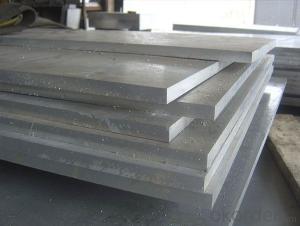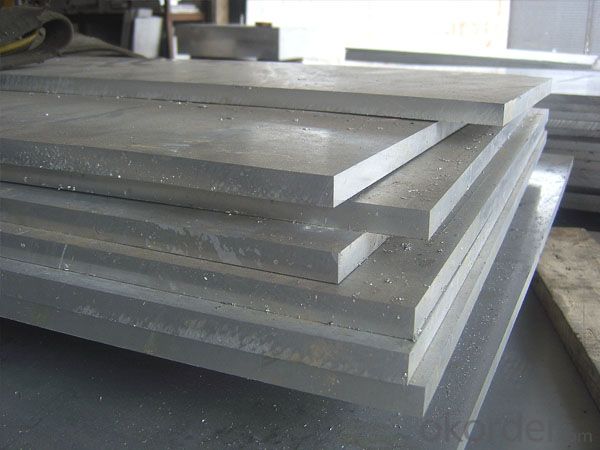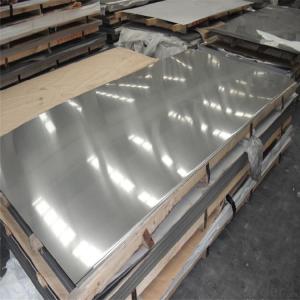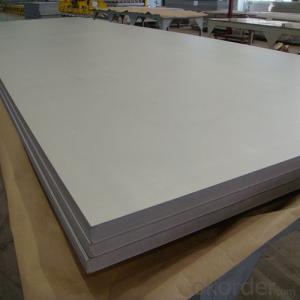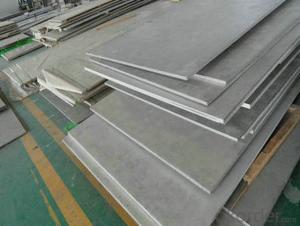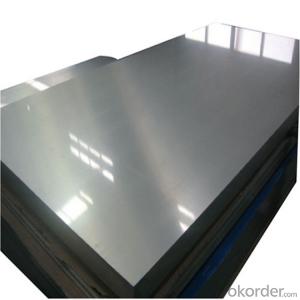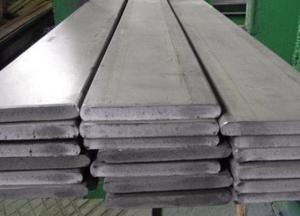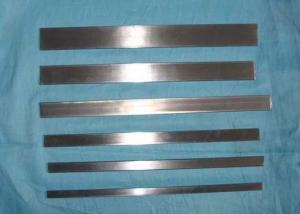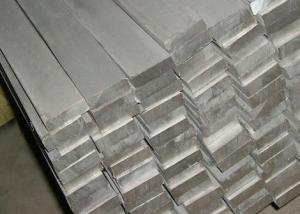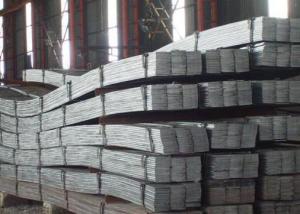Made in china 304 stainless steel dinner plate
- Loading Port:
- Tianjin
- Payment Terms:
- TT OR LC
- Min Order Qty:
- 100 kg
- Supply Capability:
- 1000 kg/month
OKorder Service Pledge
Quality Product, Order Online Tracking, Timely Delivery
OKorder Financial Service
Credit Rating, Credit Services, Credit Purchasing
You Might Also Like
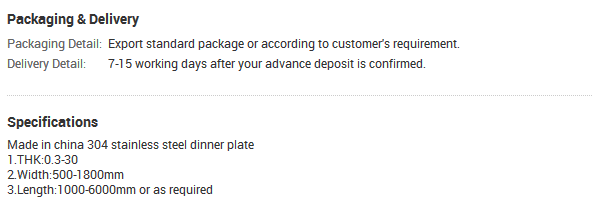
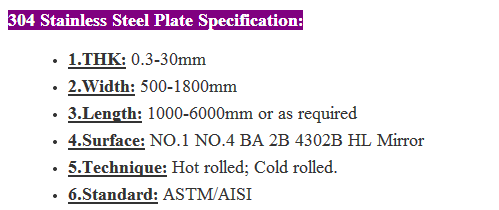

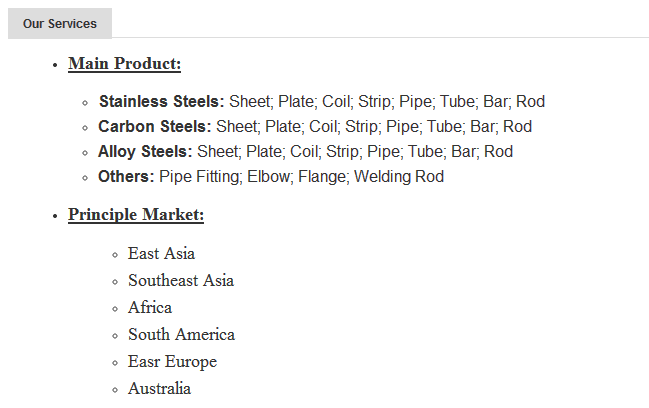
- Q: What is the difference between 304H and 304 stainless steel pipes?
- The main difference between 304H and 304 stainless steel pipes is the carbon content. 304H contains a higher carbon content, which enhances its high-temperature strength and resistance to sensitization. This makes 304H suitable for high-temperature applications, such as in refineries and power plants, where it can withstand elevated temperatures without losing its mechanical properties. On the other hand, 304 stainless steel pipes have a lower carbon content, making them more suitable for general-purpose applications that do not require high-temperature resistance.
- Q: What are the weld sleeves for stainless steel pipes?
- Set of galvanized steel pipe stainless steel pipe according to the material quota.
- Q: How do stainless steel pipes compare to carbon steel pipes?
- Stainless steel pipes and carbon steel pipes are utilized extensively in various industries and applications, but they differ in composition, strength, durability, and corrosion resistance. One main distinction between stainless steel pipes and carbon steel pipes is their composition. Stainless steel pipes are produced from an iron alloy containing a minimum of 10.5% chromium, which ensures exceptional corrosion resistance. Conversely, carbon steel pipes are primarily composed of iron and carbon, with smaller quantities of other elements. In terms of strength, carbon steel pipes generally exhibit greater rigidity and strength compared to stainless steel pipes. This characteristic renders carbon steel pipes suitable for applications necessitating high pressure or heavy load-bearing capacity. Stainless steel pipes, though not as strong as carbon steel pipes, still possess commendable strength and are suitable for various applications where corrosion resistance is a priority. When it comes to corrosion resistance, stainless steel pipes outperform carbon steel pipes. The presence of chromium in stainless steel forms a protective layer, referred to as the passive film, on the surface, which prevents corrosion and rusting. This makes stainless steel pipes ideal for use in corrosive environments, such as chemical processing, marine, and offshore industries. On the other hand, carbon steel pipes are more susceptible to corrosion and require additional protective coatings or treatments to enhance their resistance. Durability is another crucial factor to consider when comparing stainless steel pipes to carbon steel pipes. Stainless steel pipes are renowned for their long lifespan and resistance to wear and tear, making them a cost-effective option in the long term. Carbon steel pipes, while durable, may necessitate more maintenance and regular inspections to prevent corrosion and degradation. To conclude, stainless steel pipes offer superior corrosion resistance, making them more suitable for use in corrosive environments. On the other hand, carbon steel pipes are stronger and more rigid, making them suitable for applications requiring high pressure. The choice between stainless steel and carbon steel pipes ultimately depends on the specific requirements of the application, including the desired level of corrosion resistance, strength, and durability.
- Q: How do you prevent condensation in stainless steel pipes?
- To prevent condensation in stainless steel pipes, it is important to insulate the pipes properly. This can be done by using insulation materials specifically designed for pipes, such as foam or fiberglass insulation. Additionally, ensuring that the pipes are properly sealed and free from any leaks will also help minimize condensation. Proper ventilation in the area around the pipes can also help reduce moisture buildup and prevent condensation from occurring.
- Q: What is the difference between Sch 40 and Sch 80 stainless steel pipes?
- The difference between Sch 40 and Sch 80 stainless steel pipes lies in their wall thicknesses. Sch 40 refers to a pipe with a wall thickness of "Schedule 40," while Sch 80 refers to a pipe with a wall thickness of "Schedule 80." The schedule number represents the approximate wall thickness of the pipe, with higher numbers indicating thicker walls. In the case of stainless steel pipes, Sch 80 has a thicker wall compared to Sch 40. The difference in wall thickness translates to differences in pressure rating and strength. Sch 80 stainless steel pipes are designed to handle higher pressure and are generally used in applications where the pipe needs to withstand higher levels of stress or extreme conditions. On the other hand, Sch 40 stainless steel pipes are commonly used in less demanding applications where lower pressure ratings are acceptable. Additionally, the thicker wall of Sch 80 pipes results in a smaller internal diameter compared to Sch 40 pipes. This reduction in internal diameter can impact the flow rate of fluids or gases through the pipe, so it is important to consider this factor when selecting the appropriate pipe for a specific application. In summary, the main difference between Sch 40 and Sch 80 stainless steel pipes is their wall thickness, with Sch 80 pipes being thicker and capable of handling higher pressure and stress levels.
- Q: Are stainless steel pipes suitable for sanitary applications?
- Yes, stainless steel pipes are highly suitable for sanitary applications. They are corrosion-resistant, easy to clean, and have excellent hygienic properties, making them ideal for use in industries such as food and beverage, pharmaceuticals, and water treatment.
- Q: Can stainless steel pipes be used for automotive applications?
- Yes, stainless steel pipes can be used for automotive applications. Stainless steel is a highly durable material that offers excellent resistance to corrosion and heat. This makes it an ideal choice for automotive applications where pipes may be exposed to harsh environmental conditions, such as high temperatures, moisture, and road salt. Stainless steel pipes are commonly used in exhaust systems, fuel lines, and other components in automobiles. They provide superior strength and longevity compared to other materials, ensuring a longer lifespan for automotive parts and reducing the need for frequent replacements. Additionally, stainless steel pipes offer good aesthetic appeal and can be easily fabricated to meet specific design requirements for automotive applications.
- Q: How do stainless steel pipes compare to PVC-U pipes?
- Stainless steel pipes and PVC-U pipes are two commonly used materials for various piping applications, and they have their own unique characteristics and advantages. Firstly, stainless steel pipes are known for their exceptional durability and strength. They are highly resistant to corrosion, rust, and other chemical reactions, making them ideal for applications where the pipes come into contact with aggressive substances or are exposed to harsh environments. Stainless steel pipes can withstand high temperatures and pressures, making them suitable for demanding industrial applications. On the other hand, PVC-U (polyvinyl chloride unplasticized) pipes are lightweight and easy to install. They are cost-effective and have good chemical resistance, especially against most acids, alkalis, and salts. PVC-U pipes are commonly used in plumbing, irrigation, and drainage systems due to their excellent flow characteristics and low maintenance requirements. In terms of versatility, stainless steel pipes can be used for a wide range of applications, including water supply, gas distribution, oil and gas pipelines, and sewage systems. They are often preferred in industrial settings where reliability and longevity are crucial. PVC-U pipes, on the other hand, are more commonly used in residential and commercial settings where cost-efficiency and ease of installation are important factors. It is worth noting that stainless steel pipes are typically more expensive than PVC-U pipes, both in terms of material cost and installation. However, given their longer lifespan and superior resistance to corrosion and chemical reactions, they often prove to be a more cost-effective option in the long run. Ultimately, the choice between stainless steel pipes and PVC-U pipes depends on the specific requirements of the application. Factors such as cost, durability, resistance to corrosion, ease of installation, and maintenance should all be taken into consideration when comparing these two materials for a particular piping project.
- Q: How do stainless steel pipes perform in extreme weather conditions?
- Stainless steel pipes are renowned for their remarkable performance and durability in severe weather conditions. With their unique composition, stainless steel pipes possess a remarkable resistance to corrosion, rendering them ideal for usage in diverse environments, including extreme weather conditions. When faced with severely cold weather, stainless steel pipes retain their strength and flexibility, unlike other materials that may become brittle or crack. This characteristic makes them suitable for applications like oil and gas pipelines, where they can endure low temperatures without compromising their performance. Similarly, in excessively hot weather, stainless steel pipes exhibit exceptional heat resistance, preventing warping or deformation. This quality is of utmost importance in industries such as power generation, where high-temperature surroundings are prevalent. Moreover, stainless steel pipes boast a high melting point, enabling them to maintain their structural integrity even in the presence of intense heat. This renders them resistant to fire damage, guaranteeing a safe choice for applications requiring fire protection. Stainless steel pipes also possess outstanding resistance to damaging UV radiation over time. This attribute ensures that the pipes do not degrade or weaken when exposed to direct sunlight or extreme weather conditions, proving their suitability for outdoor applications. Furthermore, stainless steel pipes demonstrate excellent mechanical properties, including high tensile strength and impact resistance. These qualities enable them to endure extreme weather conditions such as high winds, heavy storms, and seismic activities without experiencing any structural failures. In conclusion, stainless steel pipes are highly dependable and perform exceptionally well in extreme weather conditions. Their resistance to corrosion, high and low temperatures, UV radiation, and mechanical stress make them the preferred choice for various industries, ensuring reliable and long-lasting performance even in the harshest environments.
- Q: Can stainless steel pipes be insulated with cellulose?
- Yes, stainless steel pipes can be insulated with cellulose. Cellulose insulation is a versatile material that can be used to insulate various types of pipes, including stainless steel ones. It provides excellent thermal insulation properties and can help prevent heat loss or gain in the pipes, improving their energy efficiency.
Send your message to us
Made in china 304 stainless steel dinner plate
- Loading Port:
- Tianjin
- Payment Terms:
- TT OR LC
- Min Order Qty:
- 100 kg
- Supply Capability:
- 1000 kg/month
OKorder Service Pledge
Quality Product, Order Online Tracking, Timely Delivery
OKorder Financial Service
Credit Rating, Credit Services, Credit Purchasing
Similar products
Hot products
Hot Searches
Related keywords
